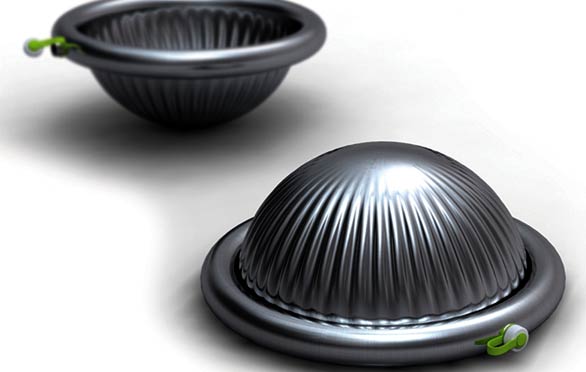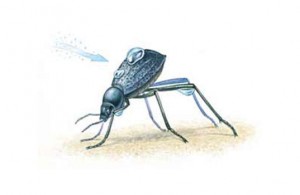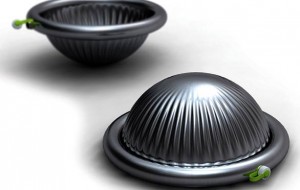I don’t know how I missed this gadget which one a design award back in 2010. It is called the DewBank and it is biomimetic device that collects and channels water into a bottle even in a desert climate. Simply place the stainless steel device on a flat, windless area in the evening and by morning it will have gathered enough water to fill a glass. It can do this because the stainless steel cools down in the evening air of the desert attracting any moisture which condenses on its surface and then runs down into a collecting bowl.
DewBank mimics the Desert Darkling Beetle, native to the Namib in Southwest Africa, one of the driest places on Earth. The beetle has adapted to the dry conditions by evolving a bumpy waxy coating that is hydrophobic (it repels water). This physical characteristic makes water run off its back and the beetle has evolved a behaviour to harvest the moisture. Like a sailboat turning into the wind, the beetle sticks its abdomen in the early morning Namib air to attract water droplets which then run down to its mouth.
DewBank features a ribbed dome which mimics the beetle’s abdomen and works exactly the same way. With the huge temperature range that occurs in desert climates the DewBank can easily attract small amounts of moisture to condense on its cool surface and then run down the ribbed channels into the covered collection reservoir.
The designer is Kitae Pak, from South Korea. It currently is not available as either a commercial or not-for-profit sponsored product. Here’s one that crowdsourcing could fund in a world where freshwater stress is increasingly seen as a problem.












[…] This particular beetle has the uncanny ability to obtain the water it needs to survive by collecting droplets of fog. How exactly does it do that? Droplets of fog are no more than 15 – 20 microns in diameter, so this is very difficult (wired.com). The beetle, over evolutionary time, has developed a pristine method to collect these tiny water droplets with ease.”The surface of Stenocara’s armor-like shell is covered with bumps. The peak of each bump is smooth, like glass, and attracts water. The slopes of each bump, and the troughs in between, are covered with wax, which repels water, like Teflon. As morning fog sweeps across the desert floor, the water sticks to the peaks of Stenocara’s bumps, eventually forming droplets. When the droplets become large and heavy enough, they roll down from the top of the peaks and are channeled to a spot on the beetle’s back that leads straight to its mouth” (nationalgeographic.com). There is a close up view of the beetle’s back and explanation of the physics behind this phenomenon on this page: http://artdthireault.blogspot.com/2011/08/desert-beetle-water-collection.html. There is also a diagram of what happens on the surface of the beetle’s back here: https://www.21stcentech.com/gizmos-gadgets-dewbank-harvests-water-desert-mists/. […]